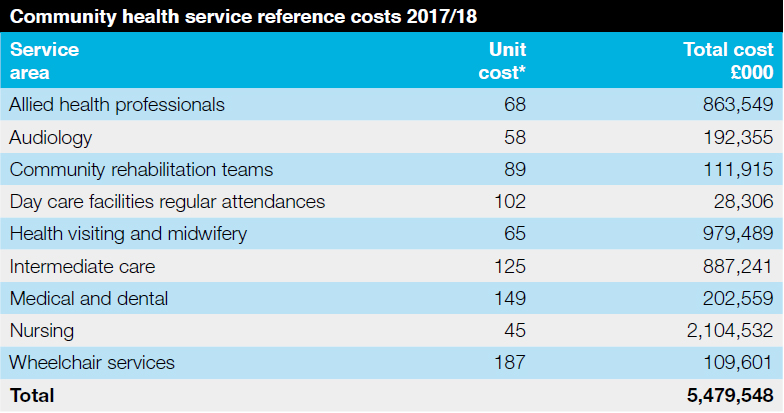NHS in numbers: community services
However it can be difficult to tie down a definition of community services. They are delivered in a wide range of settings from people’s own homes to community clinics and even schools. And while hospitals are typically linked with acute services, just to confuse matters, there are community hospitals that may provide direct access to GPs and local community staff for local populations.
Services are delivered by a range of different providers. These include small number of standalone community trusts and both integrated acute/community and integrated community/mental health trusts – 136 providers in total were registered with the Care Quality Commission last year, with just under 100 believed to be delivering significant levels of services
Services delivered in the community include: adult community services (including district nursing); specialist long-term condition nursing; planned community services (such as podiatry and speech therapy); children’s services; health and wellbeing services (including sexual health and smoking cessation); and inpatient community services.
Establishing how much is currently spent on community services is not straightforward. According to the King’s Fund, community health services have about 100 million patient contacts and account for around £10bn of the NHS budget and one-fifth of the total NHS workforce.
However NHS providers are not the only providers of community services – with some estimates suggesting they hold just over half of the total value of contracts awarded for community services. And CCGs and NHS England are not the only commissioners, with local authorities also sharing some of this responsibility.
NHS Improvement’s consolidated provider accounts for 2018/19 suggest providers’ income from community services was £7.3bn, with £6bn of this coming from CCGs and NHS England. At the same time, a recent allocation publication from NHS England says that in 2017/18, community health services accounted for 9% of total CCG core service spending (which also equates to £7.3bn).
Lord Carter’s report on community services on productivity in community and mental health services, published in 2018, put the spend on community services at £7.8bn, divided between community trusts (£2.9bn), mental health trusts (£2.2bn) and acute hospital trusts (£2.7bn).
NHS reference costs for 2017/18 cover £5.5bn of community health services costs, with nearly 40% of this being the cost of nursing and 16% covering allied health professional costs. A district nursing contact (face-to-face) costs £38 on average.
Payment for community services in the main is covered by local prices and agreements, although some community services may be covered in small numbers of pathway payment arrangements. The 2019/20 national tariff publication says that central bodies are testing a new approach to funding of community healthcare, focusing on five areas: children and young people with disabilities; single episodes of care; long-term conditions; frailty; and last year of life. A pilot was due to run until March 2020.

Related content
The value masterclass shares examples of organisations and systems that have pursued a value-driven approach and the results they have achieved.
This webinar series offers colleagues of ICS organisations the opportunity to discuss common priorities, challenges, and successes within their field.